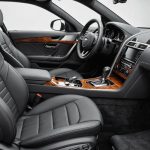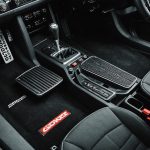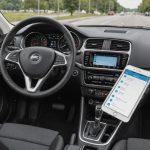Maximize Nighttime Safety: Tips to Verify Your Vehicle’s Automatic High-Beam System Functionality
Understanding the Importance of Nighttime Driving Safety
Nighttime driving can be fraught with dangers, from reduced visibility to the increased risk of accidents involving other vehicles or pedestrians. One of the key components in enhancing nighttime safety is the proper functioning of your vehicle’s headlights, particularly the automatic high-beam system. Here, we will delve into the importance of this system and provide you with practical tips to ensure it is working optimally.
The Role of Automatic High Beams
Automatic high beams are a crucial feature in modern vehicles, designed to maximize your forward visibility while minimizing glare for other drivers. This technology uses a camera sensor mounted behind the windshield to monitor the road conditions and adjust the beam settings accordingly.
Also to discover : Essential Guide to Safely Positioning a Fire Extinguisher in Your Commercial Vehicle for Instant Access
“Automatic high beams help you spot pedestrians, signs, and potential hazards more easily without having to manually toggle between light settings,” explains a spokesperson from Ford, highlighting the convenience and safety benefits of this feature[3].
Checking and Maintaining Your Headlights
Before diving into the specifics of the automatic high-beam system, it’s essential to ensure that your headlights are in good working condition.
Also to discover : Essential Guide: How to Verify Your Vehicle”s Airbag System is Operating Safely
1. Inspect Your Headlights
Make sure both headlights are functioning correctly. If one is weaker or stronger than the other, it can create uneven lighting, which can be hazardous. Check the housings and lenses for any damage or cloudiness. Cloudy or foggy headlights can significantly reduce visibility, so consider using a headlight buffering kit if necessary[1].
2. Clean Your Windshield
A clean windshield is crucial for clear visibility. Ensure that both the inside and outside of your windshield are free from dirt, dust, and other obstructions. This simple step can make a significant difference in your ability to see the road ahead at night[1].
3. Adjust Your Dash Lights
Driving with your dash lights on maximum brightness can compromise your forward vision. Dim your instrument panel and dash lights to avoid this issue and improve your nighttime driving experience[1].
Enabling and Adjusting Automatic High Beams
To get the most out of your automatic high-beam system, you need to understand how to enable and adjust it.
Steps to Enable Automatic High Beams
Here are the general steps to enable automatic high beams on your vehicle, using a Lincoln model as an example:
- Press Settings on your vehicle’s SYNC® screen.
- Choose Vehicle Settings.
- Select Lighting.
- Toggle the Auto Highbeam slider On[5].
Adjusting the System
- Ambient Light Level: The system will only activate high beams when the ambient light level is low enough to require them.
- Traffic Conditions: The system turns the high beams off if it detects an approaching vehicle’s headlamps or tail lamps, or street lighting ahead.
- Vehicle Speed: The system typically requires the vehicle to be traveling at a speed greater than approximately 52 km/h (32 mph) to activate the high beams[5].
Common Issues and Troubleshooting
While automatic high-beam systems are designed to be reliable, there can be instances where they may not function as expected.
False Activation or Deactivation
- Obstacles: The system may not switch the high beams off if the lights of oncoming vehicles are hidden by obstacles like guard rails.
- Weather Conditions: Severe weather such as fog, heavy rain, or snow can affect the system’s performance by reducing visibility[5].
Troubleshooting Tips
- Check Sensor Cleanliness: Ensure the camera sensor behind the windshield is clean and free from obstructions.
- Update Software: Sometimes, a software update may be necessary to fix any glitches in the system.
- Consult the Owner’s Manual: Refer to your vehicle’s owner’s manual for specific troubleshooting steps and guidelines.
Additional Safety Features for Nighttime Driving
Besides the automatic high-beam system, there are several other safety features and tips that can enhance your nighttime driving experience.
Night Vision Technology
Some vehicles, like the 2025 Cadillac Escalade IQ Sport, come equipped with Night Vision technology that uses thermal imaging to identify pedestrians and animals in the vehicle’s path. This feature can significantly improve safety in low-light conditions[1].
Adaptive Beam Headlights
Adaptive Beam Headlights adjust the beam pattern to reduce glare for other drivers without losing any forward lighting. This technology can increase roadway illumination by up to 86% compared to standard lights[1].
Driver-Assist Technologies
Features like Ford Co-Pilot360 and Honda Sensing® include a suite of driver-assist technologies such as Lane-Keeping Systems, Blind Spot Information Systems, and Forward Collision Warning. These features help in maintaining lane position, detecting vehicles in blind spots, and alerting the driver to potential collisions[3][4].
Practical Tips for Safe Nighttime Driving
Here are some practical tips to ensure safe nighttime driving:
Drive Defensively
Always be aware of your surroundings and drive defensively, especially at night when other drivers may be under the influence or less alert.
Avoid Drowsy Driving
Fatigue can be a significant risk factor at night. Keep yourself alert by having someone to talk to, consuming caffeine, or pulling over to rest if necessary[1].
Regular Vision Checks
Ensure your vision is not impaired by regular eye checks. Conditions like cataracts can significantly affect your ability to drive safely at night[1].
Maximizing nighttime safety involves a combination of proper vehicle maintenance, understanding and utilizing advanced safety features, and adopting safe driving practices. Here is a summary of the key points:
Key Takeaways
- Headlight Maintenance: Ensure your headlights are clean, aimed correctly, and functioning evenly.
- Enable Automatic High Beams: Follow the steps specific to your vehicle to enable this feature.
- Adjust and Troubleshoot: Adjust the system according to your needs and troubleshoot common issues.
- Additional Safety Features: Utilize other safety technologies like Night Vision and Adaptive Beam Headlights.
- Safe Driving Practices: Drive defensively, avoid drowsy driving, and get regular vision checks.
By following these tips and ensuring your vehicle’s automatic high-beam system is functioning correctly, you can significantly enhance your safety and the safety of others on the road at night.
Comparative Table of Advanced Safety Features
Here is a comparative table of some advanced safety features available in different vehicle models:
| Feature | Ford Co-Pilot360 | Honda Sensing® | Lincoln Driver-Assist |
|---|---|---|---|
| Auto High-Beam Headlamps | Automatically switches | Automatically switches | Automatically switches |
| between low and high beams | between low and high beams | between low and high beams | |
| Lane-Keeping System | Alerts and assists steering | Provides steering input | Not included |
| to keep vehicle in lane | to keep vehicle in lane | ||
| Blind Spot Information | Alerts driver of vehicles | Alerts driver of vehicles | Not included |
| in blind spot | in blind spot | ||
| Forward Collision Warning | Alerts driver of potential | Alerts driver of potential | Not included |
| collisions | collisions | ||
| Night Vision Technology | Not included | Not included | Not included |
| Adaptive Beam Headlights | Not included | Not included | Not included |
Detailed Bullet Point List for Nighttime Driving Safety
Here is a detailed list of tips to enhance your nighttime driving safety:
-
Check Your Headlights:
-
Ensure both headlights are working.
-
Clean and aim the headlights correctly.
-
Use a headlight buffering kit if necessary.
-
Use High Beams Wisely:
-
Turn off high beams within 500 feet of an approaching vehicle or when 200-300 feet behind another vehicle.
-
Use low beams when driving behind someone.
-
Keep the Windshield Clean:
-
Clean the inside and outside of the windshield.
-
Ensure no obstructions are blocking your view.
-
Dim Dash Lights:
-
Reduce the brightness of your instrument panel and dash lights.
-
Avoid Drowsy Driving:
-
Stay alert by having someone to talk to or consuming caffeine.
-
Pull over to rest if feeling fatigued.
-
Drive Defensively:
-
Be aware of other drivers who may be under the influence or less alert.
-
Anticipate potential hazards and react accordingly.
-
Get Regular Vision Checks:
-
Ensure your vision is not impaired by conditions like cataracts.
-
Avoid wearing glasses with wide frames that can restrict your vision.
By following these tips and ensuring your vehicle is equipped with the latest safety features, you can significantly reduce the risks associated with nighttime driving and make your journeys safer and more comfortable.











